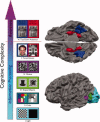Visual cognition in disorders of consciousness: from V1 to top-down attention
- PMID: 22287214
- PMCID: PMC6870132
- DOI: 10.1002/hbm.21507
Visual cognition in disorders of consciousness: from V1 to top-down attention
Abstract
What is it like to be at the lower boundaries of consciousness? Disorders of consciousness such as coma, the vegetative state, and the minimally conscious state are among the most mysterious and least understood conditions of the human brain. Particularly complicated is the assessment of residual cognitive functioning and awareness for diagnostic, rehabilitative, legal, and ethical purposes. In this article, we present a novel functional magnetic resonance imaging exploration of visual cognition in a patient with a severe disorder of consciousness. This battery of tests, first developed in healthy volunteers, assesses increasingly complex transformations of visual information along a known caudal to rostral gradient from occipital to temporal cortex. In the first five levels, the battery assesses (passive) processing of light, color, motion, coherent shapes, and object categories (i.e., faces, houses). At the final level, the battery assesses the ability to voluntarily deploy visual attention in order to focus on one of two competing stimuli. In the patient, this approach revealed appropriate brain activations, undistinguishable from those seen in healthy and aware volunteers. In addition, the ability of the patient to focus one of two competing stimuli, and switch between them on command, also suggests that he retained the ability to access, to some degree, his own visual representations.
Copyright © 2012 Wiley Periodicals, Inc.
Figures



References
-
- Beauchamp MS, Haxby JV, Jennings JE, DeYoe EA ( 1999): An fMRI version of the Farnsworth‐Munsell 100‐Hue test reveals multiple color‐selective areas in human ventral occipitotemporal cortex. Cereb Cortex 9: 257–263. - PubMed
-
- Beckmann CF, Jenkinson M, Smith SM ( 2003): General multilevel linear modeling for group analysis in FMRI. Neuroimage 20: 1052–1063. - PubMed
-
- Bekinschtein TA, Coleman MR, Niklison J III, Pickard JD, Manes FF ( 2008): Can electromyography objectively detect voluntary movement in disorders of consciousness? J Neurol Neurosurg Psychiatry 79: 826–828. - PubMed
Publication types
MeSH terms
Grants and funding
LinkOut - more resources
Full Text Sources
Medical

